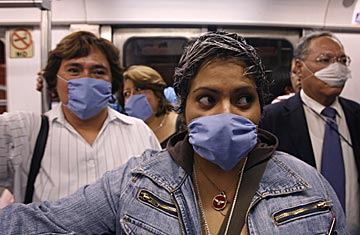
Subway riders in Mexico City wear surgical masks to avoid catching the flu, Friday, April 24.
(3 of 4)
3. Why have the U.S. cases been so much milder than the ones in Mexico?
This is the question that has health officials from Geneva to Washington puzzled. In Mexico, swine flu has caused severe respiratory disease in a number of patients — and even more worryingly, has killed the sort of young and healthy people who can normally shrug off the flu. (Fueling such concerns is the fact that similar age groups died in unusually high numbers during the 1918 pandemic.) Yet the cases in the U.S. have all been mild and likely wouldn't have even garnered much attention if doctors hadn't begun actively looking for swine flu in recent days. "What we're seeing in this country so far is not anywhere near the severity of what we're hearing about in Mexico," said the CDC's Besser. "We need to understand that."
Some of the difference may be due to the fact that Mexico has apparently been grappling with swine flu for weeks longer than the U.S. As doctors across the U.S. begin checking patients with respiratory symptoms for swine flu, CDC officials expect to see more severe cases in the U.S. as well — and as better epidemiological work is done in Mexico, we'll probably hear about more mild cases there too. Right now, however, the true severity of the H1N1 swine flu virus is still an open question, whose answer could change over time. The 1918 Spanish flu pandemic began with a fairly mild wave of infections in the spring, but the virus returned a few months later in a far more virulent form. That could happen with the current swine flu as well. "It's quite possible for this virus to evolve," said Fukuda. "When viruses evolve, clearly they can become more dangerous to people."
4. How ready is the U.S. — and the world — to respond to a flu pandemic?
In some ways, the world is better prepared for a flu pandemic today than it has ever been. Thanks to concerns over H5N1 avian flu, the WHO, the U.S. and countries around the world have stockpiled millions of doses of antivirals that can help fight swine flu as well as other strains of influenza. The U.S. has a detailed pandemic preparation plan that was drafted under former President George W. Bush. Many other countries have similar plans. SARS and bird flu have given international health officials useful practice runs for dealing with a real pandemic. We can identify new viruses faster than ever before, and we have life-saving technologies — like artificial respirators and antivirals — that weren't available back in 1918. "I believe that the world is much, much better prepared than we have ever been for dealing with this kind of situation," said Fukuda.
At the same time, the very nature of globalization puts us at greater risk. International air travel means that infections can spread very quickly. And while the WHO can prepare a new swine flu vaccine strain in fairly short order, we still use a laborious, decades-old process to manufacture vaccines, meaning it would take months before the pharmaceutical industry could produce its full capacity of doses — and even then, there wouldn't be enough for everyone on the planet. The U.S. could be particularly vulnerable; only one plant, in Stillwater, Penn., makes flu vaccine in America. In a pandemic, that could produce some ugly political debates. "Do you really think the E.U. is going to release pandemic vaccine to the U.S. when its own people need it?" asks Osterholm.
